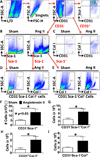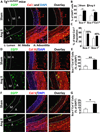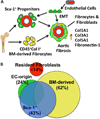Origin of Matrix-Producing Cells That Contribute to Aortic Fibrosis in Hypertension
- PMID: 26693821
- PMCID: PMC4713264
- DOI: 10.1161/HYPERTENSIONAHA.115.06123
Origin of Matrix-Producing Cells That Contribute to Aortic Fibrosis in Hypertension
Abstract
Various hypertensive stimuli lead to exuberant adventitial collagen deposition in large arteries, exacerbating blood pressure elevation and end-organ damage. Collagen production is generally attributed to resident fibroblasts; however, other cells, including resident and bone marrow-derived stem cell antigen positive (Sca-1(+)) cells and endothelial and vascular smooth muscle cells, can produce collagen and contribute to vascular stiffening. Using flow cytometry and immunofluorescence, we found that adventitial Sca-1(+) progenitor cells begin to produce collagen and acquire a fibroblast-like phenotype in hypertension. We also found that bone marrow-derived cells represent more than half of the matrix-producing cells in hypertension, and that one-third of these are Sca-1(+). Cell sorting and lineage-tracing studies showed that cells of endothelial origin contribute to no more than one fourth of adventitial collagen I(+) cells, whereas those of vascular smooth muscle lineage do not contribute. Our findings indicate that Sca-1(+) progenitor cells and bone marrow-derived infiltrating fibrocytes are major sources of arterial fibrosis in hypertension. Endothelial to mesenchymal transition likely also contributes, albeit to a lesser extent and pre-existing resident fibroblasts represent a minority of aortic collagen-producing cells in hypertension. This study shows that vascular stiffening represents a complex process involving recruitment and transformation of multiple cells types that ultimately elaborate adventitial extracellular matrix.
Keywords: adventitia; aorta; flow cytometer; hypertension; inflammation.
© 2015 American Heart Association, Inc.
Figures






Comment in
-
Progenitor Cells, Bone Marrow-Derived Fibrocytes and Endothelial-to-Mesenchymal Transition: New Players in Vascular Fibrosis.Hypertension. 2016 Feb;67(2):272-4. doi: 10.1161/HYPERTENSIONAHA.115.06220. Epub 2015 Dec 22. Hypertension. 2016. PMID: 26693817 No abstract available.
References
-
- Chandrakasan G, Bhatnagar RS. Stimulation of collagen synthesis in fibroblast cultures by superoxide. Cell Mol Biol. 1991;37:751–755. - PubMed
Publication types
MeSH terms
Substances
Grants and funding
- GM015431/GM/NIGMS NIH HHS/United States
- R37 HL057353/HL/NHLBI NIH HHS/United States
- R01 HL108701/HL/NHLBI NIH HHS/United States
- K08 HL121671/HL/NHLBI NIH HHS/United States
- R01 HL121877/HL/NHLBI NIH HHS/United States
- P01 GM015431/GM/NIGMS NIH HHS/United States
- P50 GM015431/GM/NIGMS NIH HHS/United States
- R01 HL121008/HL/NHLBI NIH HHS/United States
- R01 HL123650/HL/NHLBI NIH HHS/United States
- HL039006/HL/NHLBI NIH HHS/United States
- R01 HL039006/HL/NHLBI NIH HHS/United States
- P01 HL58000/HL/NHLBI NIH HHS/United States
- HL105294/HL/NHLBI NIH HHS/United States
- R01 HL121877U01/HL/NHLBI NIH HHS/United States
- U01 HL100398/HL/NHLBI NIH HHS/United States
- P01 HL095070/HL/NHLBI NIH HHS/United States
- P01 HL058000/HL/NHLBI NIH HHS/United States
- HL100398/HL/NHLBI NIH HHS/United States
- T32 HL007411/HL/NHLBI NIH HHS/United States
- HL057353/HL/NHLBI NIH HHS/United States
- R01 HL087867/HL/NHLBI NIH HHS/United States
- R01 HL125865/HL/NHLBI NIH HHS/United States
- R01 HL105294/HL/NHLBI NIH HHS/United States
- HL123650/HL/NHLBI NIH HHS/United States
- R01 HL057353/HL/NHLBI NIH HHS/United States
LinkOut - more resources
Full Text Sources
Other Literature Sources
Medical
Research Materials

